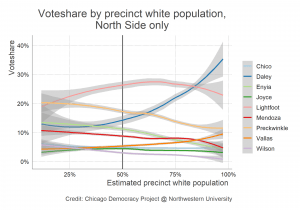(Photo credit: Ken Lund)
Is Chicago going post-racial? That question was hanging in the air on February 26, as the maps of the city’s general election results began to circulate and showed two black women—Lori Lightfoot and Toni Preckwinkle—leading the crowded field. Early next month, Chicago will be the first American city of more than a million residents to have a black woman as its mayor. It will also have only its second black mayor in more than thirty-two years. How should we interpret and explain this historic result?
In particular, the candidates’ apparent success on the city’s North Side has drawn attention. Some commentators suggested that the election’s historic outcome signals that voting patterns are no longer shaped by its racial segregation, at least in the white electorate. The New York Times‘ election postmortem declared “It Wasn’t About Race,” pointing to ward-level maps to observe that “Ms. Lightfoot and Ms. Preckwinkle appealed to mostly white communities” on the North Side. Chicago Tribune columnist Dahleen Glanton wrote that “white people in Chicago decided that it was time to have an African-American female mayor. That has never happened in our city.” The Atlantic’s CityLab noted that “[w]hile Lightfoot and Preckwinkle may not have been most of black Chicago’s preferred representatives, they were the two most popular candidates in almost half of the whiter north.” Chicago Magazine‘s Edward McClelland went so far as to argue that “[Lightfoot and Preckwinkle] are in the runoff because their campaigns transcended ethnic boundaries” and that the two candidates’ issue-based progressive agendas “may have changed Chicago politics permanently.”
This would be a remarkable transformation in a city in which white wards overwhelmingly opposed the ascension of Harold Washington to office three decades ago, and have supported white candidates ever since (well, two white candidates—because Richard M. Daley and Rahm Emanuel together won the next 7 elections).1 Four decades later, the city’s deep social inequalities and divisions have not gone away and Chicago continues to be known for its racial segregation. Despite some commentary that Chicago politics has transcended its old racial divisions, a closer look at precinct-level demographic data and voting patterns suggests that racial segregation continues to matter deeply in the city’s elections.
The aforementioned commentaries are largely based on examining ward-level maps of the winning candidate in each region. Given the well-known pattern of racial segregation in Chicago, one can infer the rough relationship between race and vote choice. But these maps leave the story incomplete. After all, Chicago is not only segregated by region, but within its regions as well. Here, I take a closer look at the voting behavior of segregated neighborhoods by shifting the level of analysis from wards to election precincts. Since demographic data on the precinct-level is not readily available, the Chicago Democracy Project used data from the Census Bureau to estimate the racial composition of each precinct.2 Using these estimates, I visualized the share of the votes that candidates won in precincts where over 50% of the population is non-Hispanic white, black, or Latinx.3 A vast majority of the city’s electorate lives in these precincts: 32% of registered Chicago voters live in majority-black precincts, 35% in majority-white ones, and 19% in majority-Latinx ones. The visualizations below plot smoothed lines representing conditional averages of candidates’ vote shares against precinct racial composition.4
The precinct-level data underscores the extent of Willie Wilson’s support in the city’s most black neighborhoods, as shown in Figure 1, as shown in Figure 1. Toni Preckwinkle was the second most-favored candidate on average in majority-black precincts, with Lori Lightfoot coming in a distant third place. While support for Wilson and Preckwinkle increase along with precincts’ black population (sharply for Wilson and slightly for Preckwinkle), support for Lightfoot is roughly even over this range.
Figure 2 shows major candidates’ vote shares in majority-Latinx precincts. Susana Mendoza outperformed all other candidates in these precincts by a considerable margin, with her support increasing in more homogeneously Latinx areas. Gery Chico also found his greatest support in such areas, although his average share of the vote was much lower than Mendoza’s and relatively close to Bill Daley’s. One reason that Mendoza’s strong showing in Latinx neighborhoods did not translate to a larger total vote share is that voter turnout was lower in highly Latinx precincts (see Figure 3, linked here). This is not surprising given Mendoza’s campaign did not seem to go beyond the ethnic cue phenomenon in efforts to attract more Latinx voters to the polls.
Turning to the city’s white neighborhoods, we can examine more closely the claim that Chicago’s white voters elevated two black women candidates to the run-off election. As Figure 4 above shows, the story is more complicated than ward-level maps suggest. In the most homogeneously white precincts, two white men, Jerry Joyce and Bill Daley, emerged as victors. Joyce’s support is indeed highly concentrated in overwhelmingly white areas. Lori Lightfoot certainly performed well in majority-white precincts, winning on average 20 percent of the vote in very-white but not entirely-white precincts. In precincts that are 80% or more white, however, Lightfoot lost ground to Daley and Joyce. Toni Preckwinkle, on the other hand, loses support steadily as precincts become more white. In some of the whitest parts of the city, ninth-place finisher Paul Vallas outperformed Preckwinkle. In majority-white precincts, Lightfoot and Preckwinkle combine, on average, for 30 percent of the vote.5 That’s more than Washington in ’83, but the claim that white Chicago chose Lightfoot and Preckwinkle as the finalists for mayor, then, seems only partially true at best.
Recalling the commentary on the election discussed earlier, we might suspect that it was white voters on the North Side in particular who were willing to vote for these two black women candidates. Figure 5 below shows the candidates’ vote share against estimated precinct white populations on the North Side alone (note that this graph plots all North Side precincts ranging from 0% to 100% white, not just those that are majority white).6 Lori Lightfoot gets consistently high support across the North Side, doing best in precincts between 50% and 75% white. Toni Preckwinkle’s North Side support, meanwhile, is more concentrated in the region’s least white areas. In the most homogeneously white North Side neighborhoods, Daley comes out on top.
The exception to Chicago’s historic pattern of white neighborhoods voting for white candidates in this cycle lies primarily in Lori Lightfoot’s performance on the North and Northwest sides (for a deeper analysis of the variation in Lightfoot and Preckwinkle’s bases, see this post). Indeed, Lightfoot performed considerably better in majority-white precincts than she did in majority-black or majority-Latinx precincts.7 In the city’s black and Latinx neighborhoods, black and Latinx candidates continued to dominate. However, it should be noted that unlike white neighborhoods, these areas have been willing to support non-black and non-Latinx candidates in the past.
It remains to be seen whether Lightfoot’s strong showing in some of the city’s whiter neighborhoods will be followed by more non-white candidates doing well among white voters in future elections. Setting aside the racial identities of the candidates, the above analysis shows that Chicago’s racially segregated neighborhoods continued to evince sharply different voting patterns in February’s election. A run-off between two black women candidates who self-identify as progressives—and who need to mobilize supporters of a dozen other candidates—may yet unsettle such patterns, but claims of Chicago politics having transcended racial segregation are overblown.
Footnotes
- In some of the whitest wards in Washington’s 1983 bid for office, upwards of 95 percent of voters supported a Republican rival with the notorious slogan “Before it’s too late.” Even in the Bridgeport heart of the Democratic machine, nearly 3 in 4 votes went against the Democratic candidate. ↩
- We used 5-year estimates from the 2012-17 American Community Survey. Because Census geography and electoral precincts do not match, estimating precinct demography involve some data processing. To make these estimates, we collected ACS data for Block Groups (BGs) and used a GIS Intersect function to create a new terrain of block-group-precinct fragments across the city. The ACS count for each measure (eg. total population, or non-hispanic white persons) was divided among each BG’s fragments according to its proportion of the BG’s overall area. Then these proportionate counts were added up according to which precinct they were in, and the estimated percentages (eg. percent non-hispanic white) were created based these newly estimated precinct counts. The key underlying assumption of this procedure is that persons in the categories of interest are evenly distributed within the BG. Because BGs are small (less than half a square mile on average in Chicago), the error potentially introduced by this procedure is outweighed by the advantage of being able to compare election results to demographic characteristics. ↩
- Since only 14 precincts have an estimated majority Asian American population, generating a similar visualization for majority Asian American precincts would not yield tractable analyses. For those who are curious, of these 14 precincts, 10 are in the 11th ward, three are in the 25th ward, and one is in the 40th ward. ↩
- A loess regression is used to generate the smoothed conditional means lines. For more details, see documentation here. Note that these visualizations do not account for differences in rates of registration and turnout across precincts. Analyses that do account for such variation show similar patterns. To see these analyses, please contact the author. ↩
- Note that this does not mean 30% of white voters chose one of these two candidates. We estimate that roughly 70% of voters in majority white precincts are non-Hispanic whites. The extent to which Lightfoot’s support was located more unevenly among the white or non-white voters in each precinct is impossible to determine with the available data. ↩
- The following wards are classified as being on the North Side: 1, 2, 32, 40, 42, 43, 44, 46, 47, 48, 49, and 50. ↩
- Pooling all the votes in these groups of precincts, Lightfoot won 21.2% of the vote in majority-white precincts, 13.9% in majority-black ones, 11.7% in majority-Latinx ones, and 21.2% in precincts with no majority group. Daley and Preckwinkle won 19.1% and 12.2% of the vote in majority-white precincts respectively. ↩






You must be logged in to post a comment.